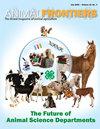牲畜作为发展规划的模型
IF 3.2
2区 农林科学
Q1 AGRICULTURE, DAIRY & ANIMAL SCIENCE
引用次数: 17
摘要
生长受限或发育受损的婴儿(例如,心脏或冠状动脉等特定器官的发育改变)不仅在婴儿时期,而且在其一生中出现健康并发症的风险都会增加。健康并发症包括病理状况,如代谢疾病(心血管疾病、糖尿病和肥胖)以及免疫功能低下、生殖功能低下、认知功能低下和普遍发育障碍(如自闭症谱系)。这一概念被命名为健康和疾病的发展起源,或发展规划(Armitage et al., 2004;巴克,2004;Wu et al., 2006;Reynolds et al., 2010;Reynolds and Caton, 2012;Vonnahme, 2012;Reynolds and vonname, 2016)。其基本思想是,子宫内或婴儿期发生的刺激或侮辱可能对个人的健康和福祉产生终身影响。世界各地的人类流行病学研究为发育规划的概念提供了令人信服的支持,表明低出生体重或其他“发育损害”,如暴露于与压力有关的激素(包括皮质类固醇,临床上广泛用于准备胎儿出生和开始分娩),以及在成年后发展上一段提到的一系列病症的后续风险(Godfrey和Barker, 2000;阿米蒂奇等人,2004;巴克,2004;Luther et al., 2009;Wallace et al., 2006;Wu et al., 2006;Reynolds et al., 2010;Reynolds and Caton, 2012;Vonnahme, 2012)。例如,表1显示了出生体重与59至70岁男性患2型(成人发病)糖尿病或糖耐量受损(糖尿病前期)的几率之间的密切关系;例如,出生时体重最低(小于5.5磅或2.5公斤)的男性患这些疾病的可能性几乎是出生时体重最高(小于9.5磅或4.3公斤)的男性的7倍。这些和上面提到的其他病理对生活质量和终身生产力有重大影响,最终会降低预期寿命。许多人类流行病学研究和包括牲畜在内的动物模型对照研究已经确定了一系列风险因素,这些因素可能会导致发育规划。这些风险因素包括生活方式选择、各种母亲因素和环境暴露(表2)。减少这种发育损害的发生率或影响有可能影响个人的即时生存和终身健康(Reynolds和Caton, 2012;Reynolds and vonname, 2016)。虽然最初的流行病学研究导致了发育规划的概念,重点关注低出生体重的个体,但我们现在知道,出生体重本身只是一个牲畜作为发育规划模型的反映本文章由计算机程序翻译,如有差异,请以英文原文为准。
Livestock as models for developmental programming
Infants that are growth-restricted or developmentally compromised (e.g., altered development of specific organs such as the heart or coronary blood vessels) have an increased risk of health complications, not just as infants, but throughout their lives. The health complications include pathological conditions like metabolic disease (cardiovascular disease, diabetes, and obesity) as well as poor immune function, poor reproductive function, poor cognitive function, and pervasive developmental disorders (e.g., autism spectrum). This concept has been named Developmental Origins of Health and Disease, or developmental programming (Armitage et al., 2004; Barker, 2004; Wu et al., 2006; Reynolds et al., 2010b; Reynolds and Caton, 2012; Vonnahme, 2012; Reynolds and Vonnahme, 2016). The basic idea is that a stimulus or insult that occurs in utero or during infancy can have lifelong effects on the health and well-being of an individual. Human epidemiological studies throughout the world have provided convincing support for the concept of developmental programming by showing a strong relationship between low birth weight, or other “developmental insults” such as exposure to stress-related hormones (including corticosteroids, which are widely used clinically to prepare the fetus for birth and to initiate delivery), and the subsequent risk of developing the range of pathologies mentioned in the previous paragraph as adults (Godfrey and Barker, 2000; Armitage et al., 2004; Barker, 2004; Luther et al., 2009; Wallace et al., 2006; Wu et al., 2006; Reynolds et al., 2010b; Reynolds and Caton, 2012; Vonnahme, 2012). As one example, Table 1 shows the strong relationship between birth weight and the odds of developing type 2 (adult onset) diabetes or impaired glucose tolerance (pre-diabetes) in men aged 59 to 70; for example, men who were born in the lowest birth weight category (< 5.5 lb or 2.5 kg) were almost 7 times more likely to develop these pathologies compared with those born in the highest birth weight category (>9.5 lb or 4.3 kg). These and the other pathologies mentioned above have a major impact on the quality of life and lifetime productivity and ultimately will reduce life expectancy. Many epidemiological studies in humans and controlled studies in animal models, including livestock, have identified a host of risk factors that provide the developmental insults that may lead to developmental programming. These risk factors include such things as lifestyle choices, various maternal factors, and environmental exposures (Table 2). Reducing the incidence or impact of such developmental insults has the potential to affect both the immediate survival and the lifelong health of an individual (Reynolds and Caton, 2012; Reynolds and Vonnahme, 2016). Whereas the initial epidemiological studies that led to the concept of developmental programming focused on individuals with low birth weight, we now know that birth weight per se is only a reflection of an Livestock as models for developmental programming
求助全文
通过发布文献求助,成功后即可免费获取论文全文。
去求助
来源期刊

Animal Frontiers
Veterinary-Food Animals
CiteScore
6.50
自引率
5.60%
发文量
74
期刊介绍:
Animal Frontiers is the official journal of the following globally active professional animal science societies:
ASAS, the American Society of Animal Science
CSAS, the Canadian Society of Animal Science
EAAP, the European Federation of Animal Science
AMSA, the American Meat Science Association
These organizations are dedicated to the advancement and dissemination of science-based knowledge concerning animal agriculture. Animal Frontiers provides a novel forum for innovative and timely perspectives that have relevance to understanding the complex dynamics at work through animal agriculture. Animal Frontiers publishes discussion and position papers that present several international perspectives on the status of high-impact, global issues in animal agriculture. Every issue will explore a theme of broad and current interest within animal science and animal agriculture.
 求助内容:
求助内容: 应助结果提醒方式:
应助结果提醒方式:


